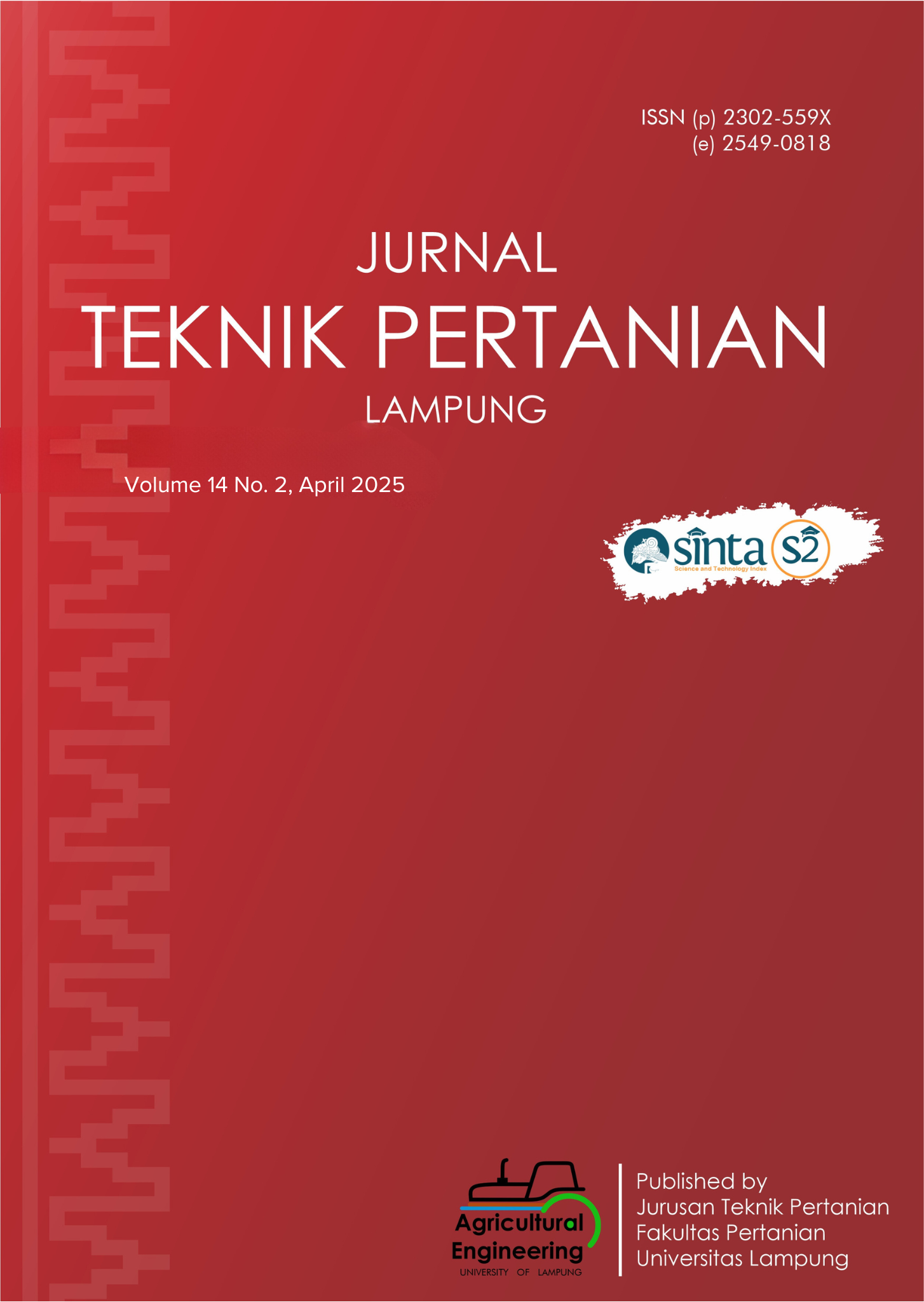Optimization of Microwave-Assisted Hydrodistillation from Indonesian White Pepper (Piper nigrum L.) Essential Oils
DOI:
https://doi.org/10.23960/jtep-l.v14i2.362-371 Abstract View: 297
Abstract View: 297
Abstract
Pepper is one of the agricultural commodities that Indonesia widely exports. Pepper can be processed into various products, including essential oils. Pepper essential oil can be extracted using several methods, including the microwave. This method can speed up the essential oil extraction process. Optimization was carried out using the Box-Behnken design using the three independent parameters: solution ratio, time, and microwave power. The upper and lower limits used for the independent variables are solvent amount of 1,350 mL and 750 mL, time of 90 minutes and 60 minutes, and microwave power of 440 watts and 136 watts. The optimal data generated is treatment with a solvent amount of 1,050 mL, 90 minutes, and 440 watts of power, resulting in validation data of 99.046%. The optimal essential oil treatment gives a specific gravity of 0.8281, a refractive index of 1.4824, solubility in ethanol 1:2, acid number 0.739 mg KOH/g, ester number 19.599 mg KOH/g, and a hue value of 186,38 (green). Oil with optimum treatment also has an IC50 antioxidant activity of 32,919.9 ppm.
Keywords: Antioxidant; Extraction; Microwave; Pepper; RSM.
Downloads
References
Abed, K.A. (2020). Effect of microwave power on the yield of essential oil from lavender. Journal of Alasmarya University, 5(2), 35–53. https://doi.org/10.59743/aujas.v5i2.1000
Al-Sayed, E., Gad, H.A., & El-Kersh, D.M. (2021). Characterization of four Piper essential oils (GC/MS and ATR-IR) coupled to chemometrics and their anti-Helicobacter pylori activity. ACS Omega, 6(39), 25652–25663.
https://doi.org/10.1021/acsomega.1c03777
Asofiei, I., Calinescu, I., Trifan, A., & Gavrila, A.I. (2019). A semi-continuous process for polyphenols extraction from sea buckthorn leaves. Scientific Reports, 9(1), 1–7. https://doi.org/10.1038/s41598-019-48610-6
Bagade, S.B., & Patil, M. (2019). Recent advances in microwave assisted extraction of bioactive compounds from complex herbal samples: A review. Critical Reviews in Analytical Chemistry, 51(2), 138–149. https://doi.org/10.1080/10408347.2019.1686966
Baliyan, S., Mukherjee, R., Priyadarshini, A., Vibhuti, A., Gupta, A., Pandey, R.P., & Chang, C.M. (2022). Determination of antioxidants by DPPH radical scavenging activity and quantitative phytochemical analysis of ficus religiosa. Molecules, 27(4). https://doi.org/10.3390/molecules27041326
Bastos, L.P.H., Vicente, J., Corrêa dos Santos, C.H., Geraldo de Carvalho, M., & Garcia-Rojas, E.E. (2020). Encapsulation of black pepper (Piper nigrum L.) essential oil with gelatin and sodium alginate by complex coacervation. Food Hydrocolloids, 102, 105605. https://doi.org/10.1016/J.FOODHYD.2019.105605
Elyemni, M., Louaste, B., Nechad, I., Elkamli, T., Bouia, A., Taleb, M., Chaouch, M., & Eloutassi, N. (2019). Extraction of essential oils of Rosmarinus officinalis L. by two different methods: Hydrodistillation and microwave-assisted hydrodistillation. The Scientific World Journal, 2019, 3659432, 6 pages. https://doi.org/10.1155/2019/3659432
Gumustepe, L., Kurt, N., Aydın, E., & Ozkan, G. (2023). Comparison of ohmic heating- and microwave-assisted extraction techniques for avocado leaves valorization: Optimization and impact on the phenolic compounds and bioactivities. Food Science and Nutrition, 11(9), 5609–5620. https://doi.org/10.1002/fsn3.3556
Hikmawanti, N.P.E., Supandi, Dwita, L.P., & Yeni. (2021). Chemical component of kencur (Kaemferia galanga L.) ethanolic extract using gas chromatography-mass spectrometry. IOP Conference Series: Earth and Environmental Science, 819(1). https://doi.org/10.1088/1755-1315/819/1/012057
Hu, Q., He, Y., Wang, F., Wu, J., Ci, Z., Chen, L., Xu, R., Yang, M., Lin, J., Han, L., & Zhang, D. (2021). Microwave technology: A novel approach to the transformation of natural metabolites. Chinese Medicine (United Kingdom), 16(1), 1–22. https://doi.org/10.1186/s13020-021-00500-8
Kang, G.-Q., Duan, W.-G., Lin, G.-S., Yu, Y.-P., Wang, X.-Y., & Lu, S.-Z. (2019). Synthesis of bioactive compounds from 3-Carene (II): Synthesis, antifungal activity and 3D-QSAR study of (Z)- and (E)-3-Caren-5-one oxime sulfonates. Molecules, 24(3), 477. https://doi.org/10.3390/molecules24030477
Katerina, V., Klara, U., Samnang, N., & Ladislav, K. (2023). Chemical composition of essential oils and supercritical carbon dioxide extracts from Amomum kravanh, Citrus hystrix and Piper nigrum ‘Kampot.’ Molecules, 28(23). https://doi.org/10.3390/molecules28237748
Khan, S., Abdo, A.A.A., Shu, Y., Zhang, Z., & Liang, T. (2023). The extraction and impact of essential oils on bioactive films and food preservation, with emphasis on antioxidant and antibacterial activities—A review. Foods, 12(22). https://doi.org/10.3390/foods12224169
Khew, C.Y., Koh, C.M.M., Chen, Y.S., Sim, S.L., & Augustine Mercer, Z.J. (2022). The current knowledge of black pepper breeding in Malaysia for future crop improvement. Scientia Horticulturae, 300, 111074. https://doi.org/10.1016/J.SCIENTA.2022.111074
Khruengsai, S., Promhom, N., Sripahco, T., Siriwat, P., & Pripdeevech, P. (2023). Optimization of enzyme-assisted microwave extraction of Zanthoxylum limonella essential oil using response surface methodology. Scientific Reports, 13(1), 1–11. https://doi.org/10.1038/s41598-023-40142-4
Lamberti, L., Grillo, G., Gallina, L., Carnaroglio, D., Chemat, F., & Cravotto, G. (2021). Microwave-assisted hydrodistillation of hop (Humulus lupulus L.) terpenes: A pilot-scale study. Foods, 10(11). https://doi.org/10.3390/foods10112726
Li, Y., Zhang, C., Pan, S., Chen, L., Liu, M., Yang, K., Zeng, X., & Tian, J. (2020). Analysis of chemical components and biological activities of essential oils from black and white pepper (Piper nigrum L.) in five provinces of southern China. LWT, 117, 108644. https://doi.org/10.1016/J.LWT.2019.108644
Menon, A.N., Padmakumari, K.P., & Jayalekshmy, A. (2003). Essential oil composition of four major cultivars of black pepper (Piper nigrum L.) III. Journal of Essential Oil Research, 15(3), 155–157. https://doi.org/10.1080/10412905.2003.9712099
Moradi, S., Fazlali, A., & Hamedi, H. (2018). Microwave-assisted hydro-distillation of essential oil from rosemary: Comparison with traditional distillation. Avicenna Journal of Medical Biotechnology, 10(1), 22–28.
Muwaffaq, M.A., & Supriyo, E. (2021). Optimization of clove flower oil extraction (Syzgium aromaticum L.) with factorial design method. Journal of Vocational Studies on Applied Research, 3(2), 38–41. https://doi.org/10.14710/jvsar.v3i2.12182
Osorio-Tobón, J.F. (2020). Recent advances and comparisons of conventional and alternative extraction techniques of phenolic compounds. Journal of Food Science and Technology, 57(12), 4299–4315. https://doi.org/10.1007/s13197-020-04433-2
Radivojac, A., Bera, O., Zeković, Z., Teslić, N., Mrkonjić, Ž., Bursać Kovačević, D., Putnik, P., & Pavlić, B. (2021). Extraction of peppermint essential oils and lipophilic compounds: Assessment of process inetics and environmental impacts with multiple techniques. Molecules, 26(10). https://doi.org/10.3390/molecules26102879
Rmili, R., Ramdani, M., Ghazi, Z., Saidi, N., & El Mahi, B. (2014). Composition comparison of essential oils extracted by hydrodistillation and microwave-assisted hydrodistillation from Piper nigrum L. Journal of Materials and Environmental Science, 5(5), 1360–1367.
Shintawati, Analianasari, & Zukryandry. (2020). Kinetika ekstraksi minyak atsiri lada hitam (Piper nigrum) secara Hidrodistilasi. CHEESA: Chemical Engineering Research Articles, 3(2), 63. https://doi.org/10.25273/cheesa.v3i2.7388.63-70
Syahadat, A., & Diningsih, A. (2022). Identification of specific gravity and solubility in ethanol from citronella oil. Journal of Public Health and Pharmacy, 2(1), 1–3. https://doi.org/10.56338/jphp.v2i1.3727
Tran, T.H., Nguyen, D.C., Nguyen Phu, T.N., Ho, V.T.T., Vo, D.V.N., Bach, L.G., & Nguyen, T.D. (2019). Research on lemongrass oil extraction technology (Hydrodistillation, microwave-assisted hydrodistillation). Indonesian Journal of Chemistry, 19(4), 1000–1007. https://doi.org/10.22146/ijc.40883
Wang, Y., Li, R., Jiang, Z.T., Tan, J., Tang, S.H., Li, T.T., Liang, L.L., He, H.J., Liu, Y.M., Li, J.T., & Zhang, X.C. (2018). Green and solvent-free simultaneous ultrasonic-microwave assisted extraction of essential oil from white and black peppers. Industrial Crops and Products, 114(January), 164–172. https://doi.org/10.1016/j.indcrop.2018.02.002
Wang, Y., Wang, L., Tan, J., Li, R., Jiang, Z.T., & Tang, S.H. (2021). Comparative analysis of intracellular and in vitro antioxidant
activities of essential oil from white and black pepper (Piper nigrum L.). Frontiers in Pharmacology, 12(June), 1–11. https://doi.org/10.3389/fphar.2021.680754
Yang, C., Shang, H., Li, J., Fan, X., Sun, J., & Duan, A. (2023). A review on the microwave-assisted pyrolysis of waste plastics. Processes, 11(5). https://doi.org/10.3390/pr11051487
Yasin, G., Bhanger, M.I., Ansari, T.M., Naqvi, S.M.S.R., Ashraf, M., Ahmad, K., & Talpur, F.N. (2013). Quality and chemistry of crude oils. In Proceedings of the 6th International Conference on Petroleum Engineering and Petrochemical Engineering (pp. 1-6).
Yensusnimar, D. (2021). Hydrocarbon saturation and chromatograms of different depths in 3 ( three ) wells which represents higher level of biodegradation toward oil water contact in reservoir ( Head et al., 013). Scientific Contributions Oil and Gas, 44(3), 173–181.
Downloads
Published
How to Cite
Issue
Section
License
Authors who publish with this journal agree to the following terms:
Authors retain copyright and grant the journal right of first publication with the work simultaneously licensed under a Creative Commons Attribution-ShareAlike 4.0 International Lice that allows others to share the work with an acknowledgement of the work's authorship and initial publication in this journal.
Authors are able to enter into separate, additional contractual arrangements for the non-exclusive distribution of the journal's published version of the work (e.g., post it to an institutional repository or publish it in a book), with an acknowledgement of its initial publication in this journal.
Authors are permitted and encouraged to post their work online (e.g., in institutional repositories or on their website) prior to and during the submission process, as it can lead to productive exchanges, as well as earlier and greater citation of published work (See The Effect of Open Access).
Jurnal Teknik Pertanian Lampung

JTEPL is licensed under a Creative Commons Attribution-ShareAlike 4.0 International License.













